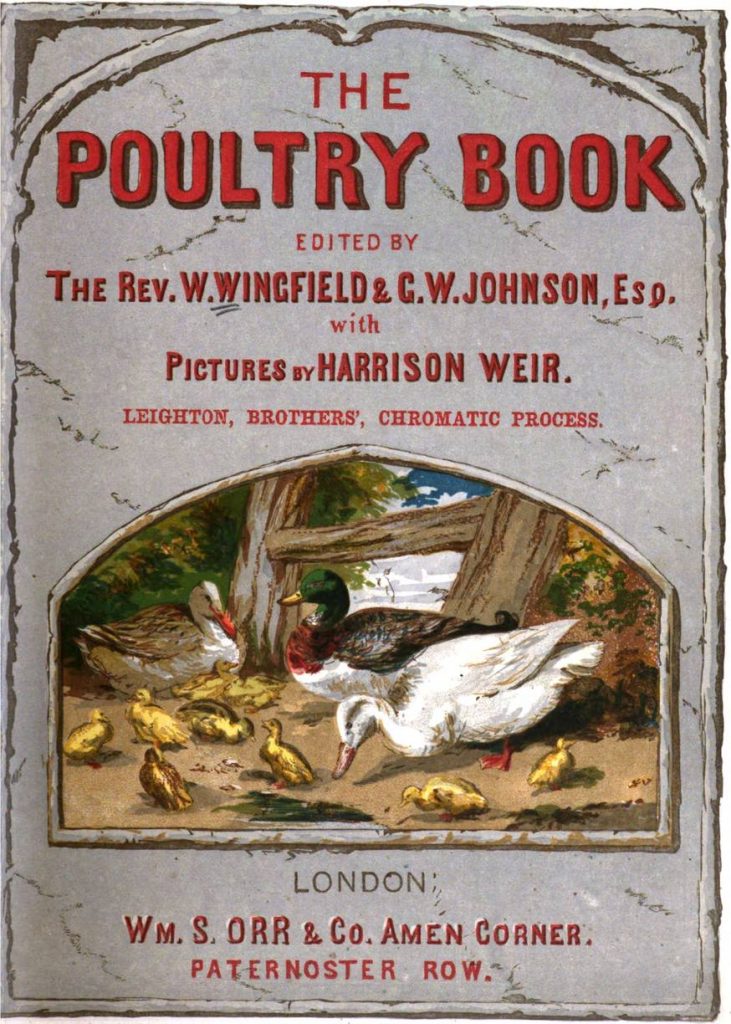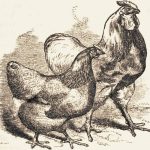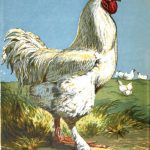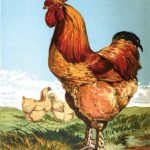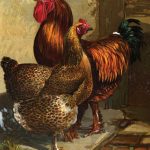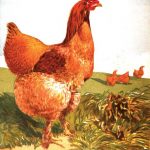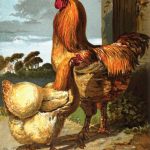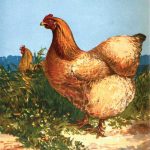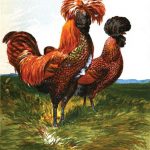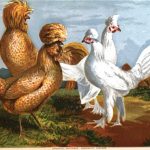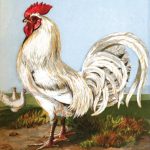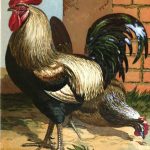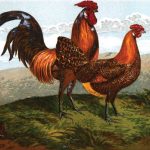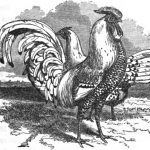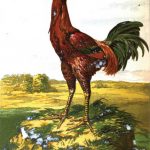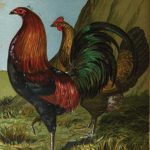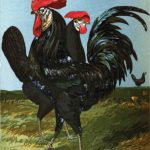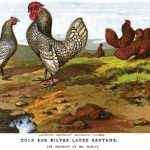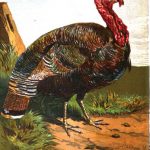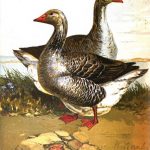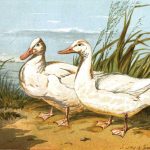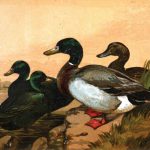The cover was in colour which was unusual for the time. This was clever marketing, emphasising the the fact that the book contained illustrations in colour at a time when this would be a rarity. The paintings were reproduced using the Leighton Brother’s Chromatic Process.
The Reverend W Wingfield was the Honorary Secretary of the Cornwall Poultry Society. Mr Johnson was the Honorary Secretary of the Winchester Society for the Improvement of Poultry.
The stunning pictures were by Harrison Weir (5 May 1824 – 3 January 1906) who was a gifted artist. As well as being somewhat famous for his poultry paintings he was also known as The Father of the Cat Fancy. He organised the first cat show in England at Crystal Palace in 1871
Follow the links below to see those paintings along with extracts and comments on the text.
Preface to The Poultry Book from 1853 with Comments
WE remember, in one of the old satirists of the Tudor period, to have observed the superlative of contempt to have been concentrated in the epithet—" Thou keeper of capons." Hence, those who gave th...
Around the 1850's there were two schools of thought regarding Cochin-China hens and Shanghai (spelt Shanghae at that time) hens. One was that they were separate breeds and the other that they were actually they same.
This argument is covered...
Who would have thought in 1850 that we'd know the name of individual chickens never mind their owners and breeders 170 years later!
As Mr Sturgeon's letter to the authors of the Poultry Book of 1853 shows, the start of Cochins as a breed didn't...
As with any domesticated animal, breeders would produce 'sub-varieties' from the main. The Partridge being so called due to the plumage colour, of course, not a cross-breeding with another species which is impossible.
Mr Punchard was apparently...
The Poultry Book of 1853 has this to say about cinnamon Cochins which were referred to as Shanghaes then.
The Buff hens vary from a dark fawn to a light yellow, or almost a canary colour; and the nearer they approach the latter shade the more they...
The most striking thing in this picture is the large difference in size between the male and female. Although these illustrations are works of art, they're also technical drawings and so I assume the relative sizes are correct.
This is backed up...
According to the book, the minimum weight at maturity should be some 8½ lbs with the cock being some 11 lbs, so not small birds by any means. There's not a great deal of discussion of egg production in relation to the breed but he is primarily interested ...
Of all the breeds of chicken, the Polish have to be the most amazing. Their amazing head feathers forming bonnets above the incredible neck feathers and beautiful plumage.
The premier breeder at this time was Mr W G Vivian whose hens these were....
Yet more of Mr Vivian's Polish hens. The Buff Polish have the classic Polish bonnet but the White Polish to the right of the picture have a different head feather style.
They also seem to have long leg feathers whereas the Buff Polish don't.
Polish...
This white Dorking Cockerel, with his magnificent tail feathers, was the property of Harrison Weir, the artist himself who painted the cockerel for the Poultry Book in 1853
Sadly there were colour plates of chickens in the original 1853 Poultry...
The name doesn't really do them justice, Captain Hornby's 'Grey Dorkings' were anything but grey and boring and by the second version of this book in 1867 this illustration was renamed Coloured Dorkings
The Poultry Book of 1853 has this to say about...
History of Hamburgh Chickens
The Poultry Book of 1853 has this to say on the origins of the Hamburgh chickens:
It deserves our notice that all tradition, all our oldest naturalists, and even the names by which onr fowls were originally called,...
With the Hamburgh fowl and some other breeds there are references to both spangled and pencilled feathers. The Poultry Book of 1853 explains what these are and helpfully provides illustrations of both feather markings.
The Poultry Book 1853 has...
"This [Malay Chickens] is another of the tenants of our poultry yard for which we are indebted to tropical latitudes, and which, though natives of such a constantly torrid climate, have the power of enduring, uninjured, temperatures so varying, so...
Another of Captain Hornby's birds. Sadly one of the main reasons for breeding these beautiful English game fowl had been cock fighting. This was not legal in England and Wales at the time the book was written having been banned in 1835 but was legal i...
These Black Spanish Chickens Belonging to Captain Hornby R. N.(obviously the second son of the family as the heir wouldn't risk himself in the navy!) these really do look Spanish to me.
You can imagine this pair breaking out into a Flamenco, definitely...
Bantam chickens are very popular today with domestic poultry keepers. They're smaller birds which many find less intimidating than full size birds. It's true that a full-sized, aggressive cockerel is a fearsome beast and not to be recommended for...
Nowadays we tend to just think of turkey's as just the Christmas dinner and Easter treat (OK, Thanksgiving for our American visitors but we don't have that holiday in Britain)
Back in the 1850s they were bred in much the same way, although on a...
From The Poultry Book, 1853
Toulouse Geese
We now come to the Toulouse Goose, some of the earliest birds of which breed were imported by the late Earl of Derby from the south of France,—Marseilles, if we remember right.
Like the Embden variety, t...
I have a special liking for this painting of the Aylesbury duck as it reminds me of pet ducks Bumble & Bee sadly now swimming and chasing the ladies in the big pond in the sky.
It's very interesting to note the comments regarding egg production....
There's quite a long and quite amusing discussion in The Poultry Book (1853) as to the origins of these ducks. Basically they take half a page to say they don't know!
Black East Indian Ducks or Buenos Aryean Ducks
The Black East Indian, or Buenos-Ayrean...

